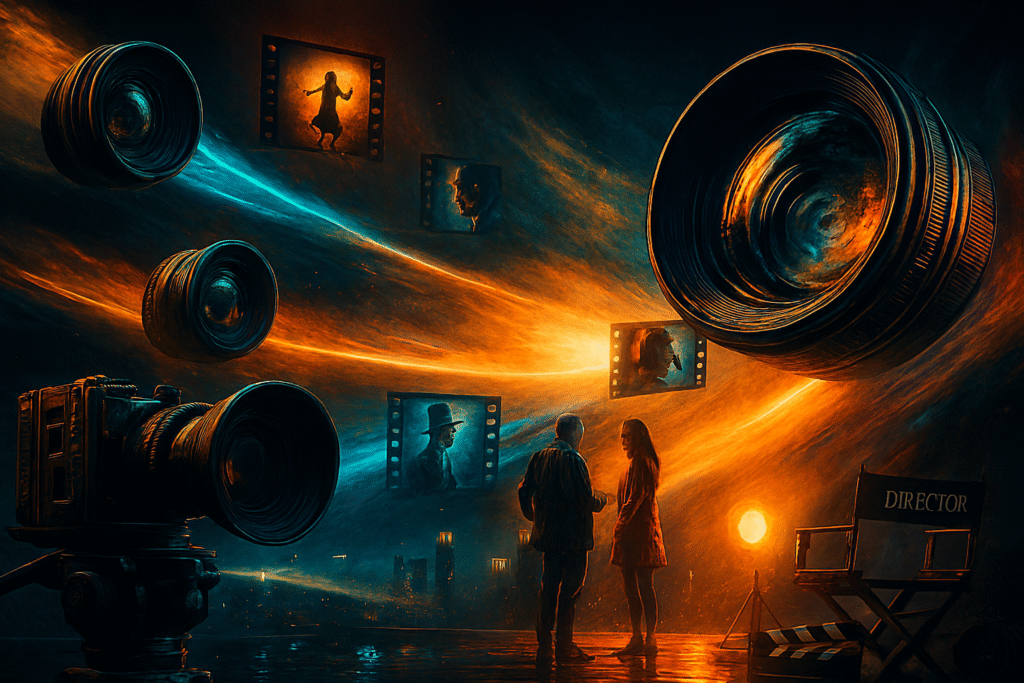Film cinematography is the art of capturing moving images. It tells a story with pictures. It uses camera work, lights, composition, colors, and camera movement. All these parts work together. They show emotions, themes, and the story in a film.
Understanding Cinematography
What is Cinematography?
Cinematography is the art of capturing moving images with a camera. It tells a story using light, color, camera angles, and what is shown in each frame. Good cinematography helps the audience feel emotions and understand the story.
Key Elements of Cinematography

1. Camera Work
Camera work is how a camera is used to capture scenes. It includes shots, angles, and movement.
Key points:
- Camera types: DSLR, mobile, cinema cameras
- Lenses: Prime, zoom, wide-angle, telephoto
- Exposure: Aperture, shutter speed, ISO
2. Lighting
Lighting sets the mood and tone. It highlights subjects and creates depth.
Techniques:
- Three-point lighting: Key light, fill light, backlight
- Modifiers: Diffusers, bounce techniques
- Mood: High-key (bright) vs. low-key (dark) lighting
3. Composition
Composition is how things are arranged in the frame. It guides the viewer’s eye and highlights important parts.
Principles:
- Rule of thirds
- Leading lines
- Framing and depth
- Symmetry and balance
4. Color Theory & Grading
Color tells a story through mood, time, and symbolism. Grading changes colors in post-production for the final look.
Elements:
- Hue, saturation, brightness
- Color temperature
- Complementary/analogous palettes
- White balance
5. Camera Movement
Camera movement makes scenes feel alive. It affects how viewers see space and time.
Techniques:
- Pan, tilt
- Dolly/tracking shots
- Zoom, crane/jib
- Handheld, Steadicam, drone shots
Visual Storytelling
Visual storytelling uses all parts of cinematography to tell a story without words. It creates emotion and draws viewers in.
Aspects:
- Combines camera work, lighting, composition, color, and movement
- Evokes emotions and themes
- Makes the story clear and engaging

Real-Life Example: Oppenheimer
Christopher Nolan’s film Oppenheimer shows great cinematography. Hoyte van Hoytema used IMAX cameras to show both tiny subatomic views and large landscapes. His work won Best Cinematography at the 2024 Oscars.
Strengths of Cinematography
- Emotional engagement: Helps viewers feel the story
- Narrative clarity: Makes the story easier to follow
- Aesthetic appeal: Creates beautiful visuals
Challenges
- Over-reliance on visuals: Can overshadow the story
- Budget: High-quality cinematography is expensive
- Technical skill: Needs trained professionals and good equipment
Cinematography vs. Photography
| Aspect | Cinematography | Photography |
|---|---|---|
| Medium | Moving images (film/digital) | Still images (film/digital) |
| Time Element | Temporal (captures motion) | Timeless (captures a single moment) |
| Equipment | Cameras, lenses, lighting, stabilizers | Cameras, lenses, lighting |
| Purpose | Storytelling through motion | Artistic or documentary expression |
| Crew Involvement | Director of Photography, camera crew | Photographer, assistants |
Frequently Asked Questions
1. What is the difference between cinematography and videography?
Cinematography focuses on the artistic and technical aspects of film production, while videography is more concerned with capturing events as they happen, often with less emphasis on style.
2. Can cinematography be self-taught?
Yes, many filmmakers start by learning cinematography through online resources, practice, and feedback.
3. What equipment is essential for cinematography?
Essential equipment includes a quality camera, lenses, tripods, stabilizers, lighting kits, and editing software.
4. How does lighting affect cinematography?
Lighting sets the mood, highlights subjects, and can create depth and texture in a scene.
5. What is the role of a cinematographer?
A cinematographer, or Director of Photography, is responsible for capturing the visual elements of a film, working closely with the director to achieve the desired look and feel.
Conclusion
Cinematography is an important part of making films. It mixes technical skills with creative vision. By using camera work, lighting, composition, color, and movement, filmmakers can tell stories that connect with viewers.
Author Bio
Ryan, Camp Films
Ryan is an experienced cinematographer and educator at Camp Films, specializing in visual storytelling and filmmaking techniques. With a background in both practical and theoretical aspects of cinematography, Ryan provides insights and tutorials to aspiring filmmakers.
References
- American Film Institute. (2023). What is Cinematography and What Does a Cinematographer Do?
- Boords. (2023). What is Cinematography? Definition & Examples.
- Encyclopædia Britannica. (2025). Cinematography.
- Shutterstock. (2023). Cinematography Definition: The Art of Visual Storytelling.


